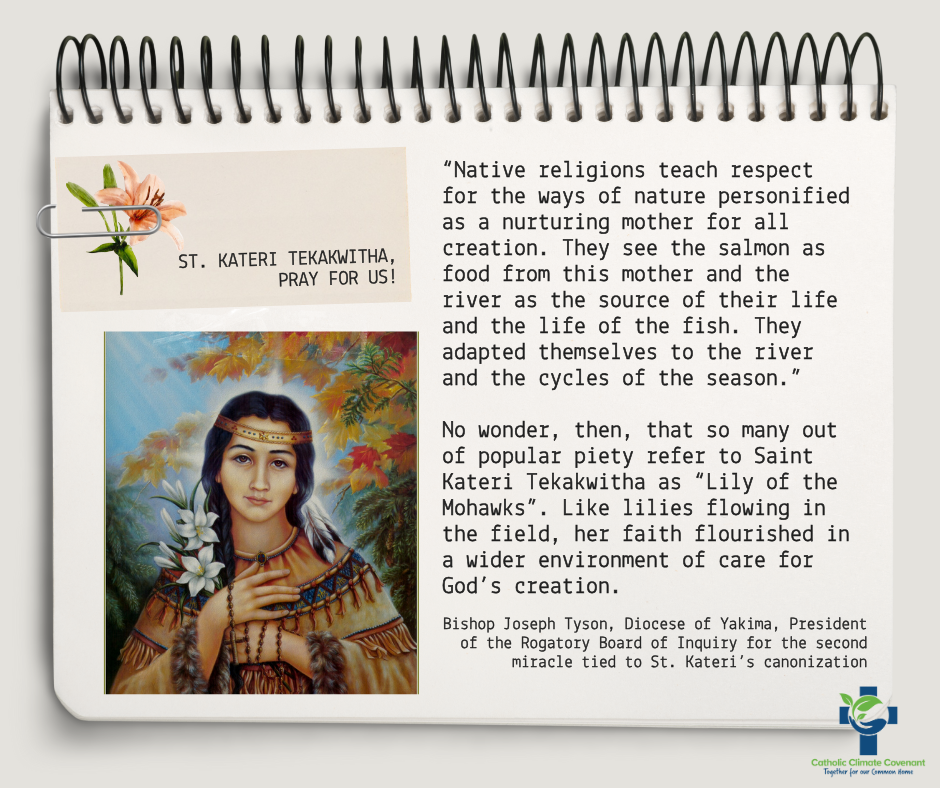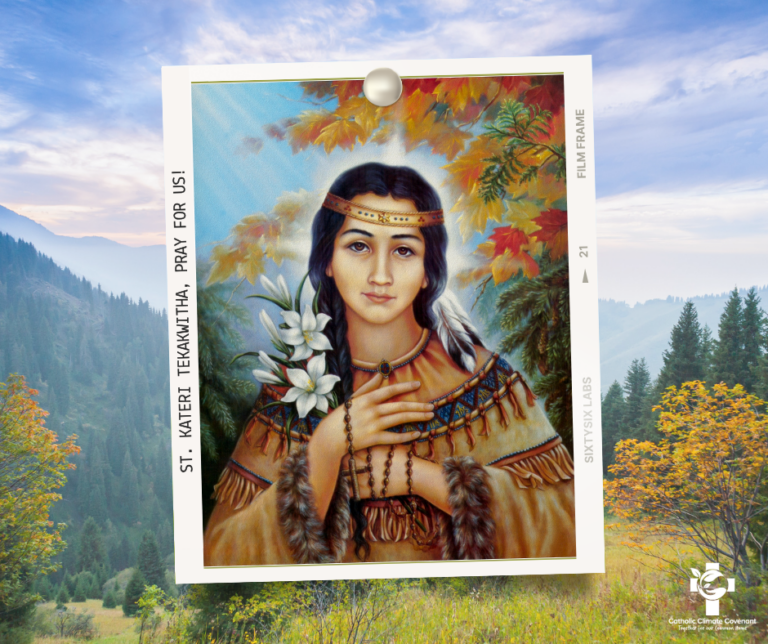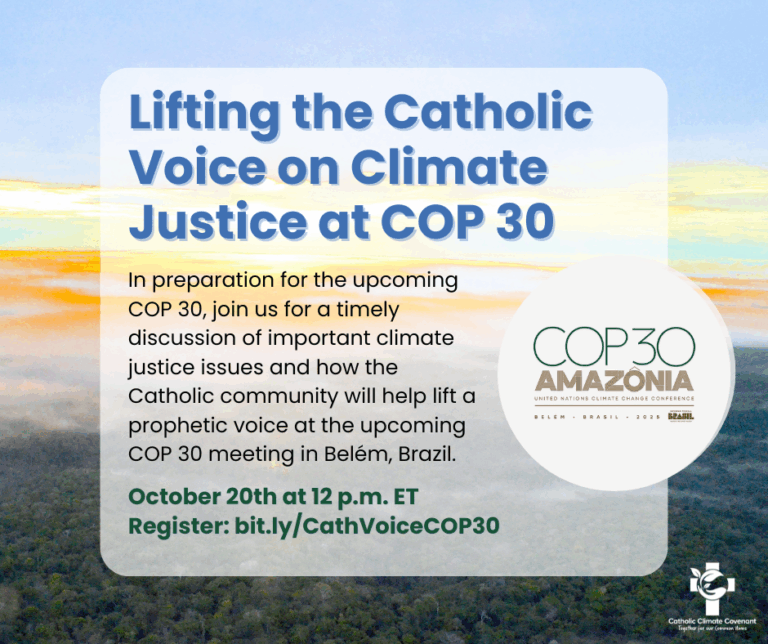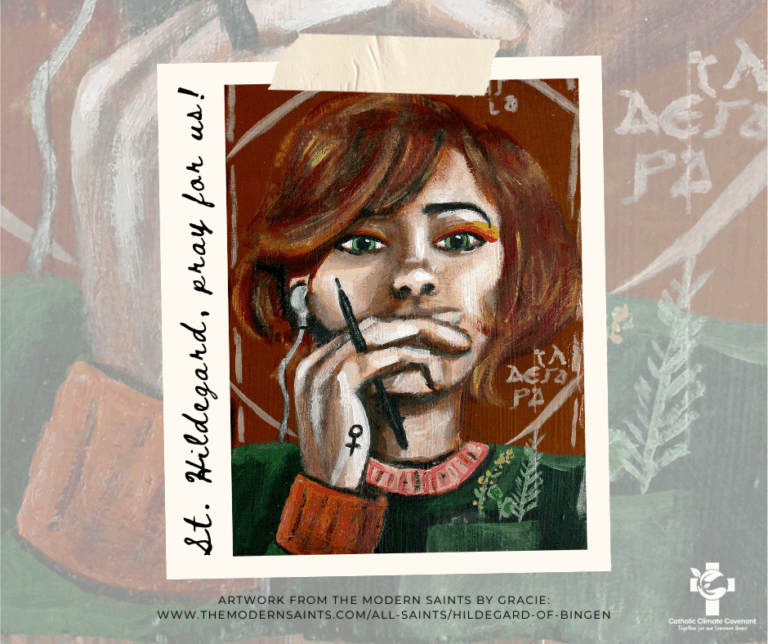Bishop Joseph J. Tyson is the Episcopal Moderator for Catholic Climate Covenant and the Bishop of the Diocese of Yakima, Washington. He was involved with the canonization process for St. Kateri Tekakwitha, a Mohawk woman who overcame illnesses and poor eyesight and still cared for creation in the world around her. The second miracle that led to her canonization on Oct. 21, 2012, took place in the Diocese of Yakima and involved a young Indigenous boy on a local reservation.
In honor of St. Kateri’s feast day on July 14, Bishop Tyson wrote the following reflection.
____________
Dear Friends:
Here at Catholic Climate Covenant, we recall with special affection Saint Kateri Tekakwitha — often remembered as the first Indigenous woman saint.
In a manner similar to San Juan Diego — the Church’s first Indigenous saint — who heard the message of the Blessed Virgin Mary in Tepeyec in his native Nahuatl, Saint Kateri Tekakwitha bore witness to Christ with and for her Mohawk people.
With the wider Church, at Catholic Climate Covenant, we elevate her witness in the context of native America and the First Nation legacy of great respect and care for creation. As we bishops of the Pacific Northwest and western Canada noted in our joint pastoral letter “The Columbia River Watershed: Caring for Creation and the Common Good”:
“Native religions taught respect for the ways of nature personified as a nurturing mother for all creation. They see the salmon as food from this mother and the river as the source of their life and the life of the fish. They adapted themselves to the river and the cycles of the season.”
No wonder, then, that so many out of popular piety refer to Saint Kateri Tekakwitha as “Lily of the Mohawks.” Like lilies flowing in the field, her faith flourished in a wider environment of care for God’s creation.
Having been president of the rogatory board of inquiry for the second miracle tied to her canonization, I want to make this second point. To verify a miracle, those examining the evidence in favor of a miracle use scientific methodology. In the case of the second miracle, I came to know Jake Finkbonner, who at the time of the miracle was six years old and suffering from a life-threatening necrotizing fasciitis. Prayers of intercession and the presence of a first-class relic of Saint Kateri Tekakwitha were key. I asked the surgeons and attending physicians that in light of the fact that every child would get first-class, top-notch care, why did Jake survive when others didn’t?
But it was the medical records showing a dramatic drop in the reactive c protein that indicated a sudden and miraculous drop in infection. And the time of the drop on the medical charts aligned completely with the precise time people prayed through the intercession of Saint Kateri Tekakwitha. We saw the time stamps on emails as well as notes taken during the prayer.
The point here is key: While miracles may occur outside what science may grasp, those of us involved with certifying a miracle — from the front line rogatory boards of inquiry to those in Rome on the dicasterial level — utilize science as a tool to faith. From Fr. George Lamaître’s contributions to “big bang theory” back to the medieval Benedictine abbot Gregor Mendel and his pea pod experiments leading to genetic theory, some form of scientific method has highlighted for believers the gift of creation.
This is precisely what Pope Francis does in his watershed encyclical Laudato Si’. Among the many important features is the number of peer-reviewed longitudinal studies tracking the growing climate crisis and its negative effects. Sadly, in our social climate of polarization, so many dismiss the sciences as political propaganda. Many propose “alternative facts.”
Yet, both Saint Juan Diego, our first Indigenous saint, and Saint Kateri Tekakwitha, our first Indigenous woman saint, show us a way forward. It was the “roses of December” that convinced the bishop to listen to the Nahuatl-speaking Juan Diego. Similarly, Saint Kateri Tekakwitha’s Mohawk nation embedded a reverence and a closeness for creation into their First Nation’s stories and legends.
Can we reverently read the signs of creation and the “signs of the times”? Can we view the science of creation out of awe and reverence because we are studying God’s very gift to us as humans who share the earth as a common home? Like the saints, can we do so out of our love and devotion to Jesus Christ, “the firstborn of creation,” whose salvific intent is “all creation”?
Most especially in this Holy Year 2025, can we be Pilgrims of Hope in a fallen world? Hope is a virtue. Hope is not a false optimism that things will get better. Indeed, things are getting worse with regard to environmental policy. Hope gives meaning that whatever the ups and downs, we point those around us back to God the giver of creation, to Jesus Christ who comes to redeem creation in a fallen world, and to the Holy Spirit whose very gifts encourage us to be the very best women and men — the very best stewards — we were created to be!
Saint Kateri Tekakwitha, pray for us!
Bishop Joseph Jude Tyson has been the Bishop of Yakima Diocese since 2011 and serves as a member of the USCCB’s committee for Cultural Diversity and is Chair of the USCCB’s Pastoral Care for Migrants, Refugees, and Travelers. He was ordained to the priesthood in 1989 and holds a Bachelor of Arts degree from the University of Washington, a Master’s in International Relations from the University of Washington, a Master of Divinity from the Catholic University of America, and an honorary Doctorate of Letters from St. Martin’s University in Lacy, Washington.




